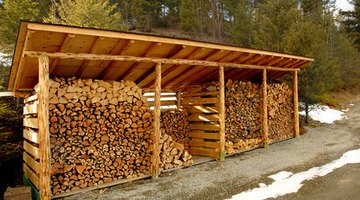How to Build an Open Pole Shed
Open-pole sheds have been around for centuries and are probably the easiest type of shed to build. They can be any size and are used for carports, firewood storage, animal shelters, hay storage, farm implement storage, bus shelters, picnic shelters and more.

Traditionally built with poles, they originally did not last long because the wood rotted and was eaten by termites. Modern pre-treated and pressurized lumber is resistant to weathering and termites and lasts much longer.
Things You Will Need
- Treated poles or 4-by-6 posts for uprights
- Treated poles or 2-by-6 lumber for beams and rafters
- Corrugated roofing sheets -- metal or plastic
- Planks for forms
- Concrete --ready mix, or use sand, stones and cement and mix it yourself
- Wheelbarrow
- Stepladder
- Hole auger or digger
- Hammer and nails
- Galvanized screws and bolts
- Screw gun
- Nail gun
- Shovel or Bobcat
- Saw
- Plumb line
-
Contact your local city or county planning and zoning department to determine if you can build a pole shed on your property. Some subdivisions have deed restrictions that could prevent you from building your shed, and in some places, zoning does not allow pole sheds. Obtaining a permit in advance will prevent you from being fined later.
-
Draw a plan for the shed with dimensions, and compile a list of materials. You will most likely have to provide these with your permit application. You will also need to draw a plot plan, showing the proposed shed's location in relation to your home and other structures, and to your property boundaries. Most counties have setback regulations to prevent structures being built to close to the neighboring lots.
-
Level the area where you plan to build the shed and clear it of vegetation. If you are not lucky enough to have a Bobcat, you can do this with a shovel. Make sure you choose a spot that will drain when it rains. If you plan to have a concrete floor, you can set the forms and pour the concrete first, or wait until after the shed is up. There is no advantage either way -- it is simply a matter of whatever works best for you.
-
Cut the poles or posts to length -- a sloping roof is best if you want rain water to drain. Decide on the angle of the slope, and cut the two rear posts a few inches shorter than the front posts. Dig or auger holes for the posts, at least 18 inches deep, and plant the posts firmly in the ground. Use a plumb line to make sure they are straight. Pour some concrete into the holes and tamp around them to hold the posts tightly. Top up the holes with dirt and tamp again.
-
Set up the forms for a concrete floor. Spread pieces of scrap metal, rebar or wire to reinforce the concrete. Be sure the forms are square. Mix and pour the concrete into the forms and allow it to set. You can also do this before putting the posts in the ground, and place the posts outside the floor afterward. Alternatively, you may choose to have an earth floor.
-
Attach your beams to the tops of the posts or poles. They may be attached by notching the post or using narrower twin parallel beams on either side of the post. Attach with stainless-steel lugs, washers and nuts.
-
Install the rafters across the beams using galvanized screws. The number of rafters and spaces between them will depend upon how much support you want to provide for your roof. If you are in an area where it snows, you should space them no further than 16 inches apart. You can add battens to make the structure stronger if you wish.
-
Lay the roofing material one sheet at a time, and hammer it on using roofing nails. Make sure the channels in the roof are directed toward the back so that rain water will drain to the rear of the shed. You may have to cut the roof to fit, or you can overlap the sheets.
The Drip Cap
- Open-pole sheds have been around for centuries and are probably the easiest type of shed to build.
- You will also need to draw a plot plan, showing the proposed shed's location in relation to your home and other structures, and to your property boundaries.
- If you plan to have a concrete floor, you can set the forms and pour the concrete first, or wait until after the shed is up.
- Dig or auger holes for the posts, at least 18 inches deep, and plant the posts firmly in the ground.
- Use a plumb line to make sure they are straight.
- Spread pieces of scrap metal, rebar or wire to reinforce the concrete.
- Attach your beams to the tops of the posts or poles.
- You may have to cut the roof to fit, or you can overlap the sheets.
Writer Bio
Trish Jackson is an author, blogger and freelance writer. Her second romantic suspense novel, "Redneck P.I.," was released in March 2011. Jackson particularly likes to write articles relating to life in the country, animals and home projects and has kept a blog focusing on this since 2006.
Photo Credits
- shed outdoors with firewood inside image by SZILAGYI ANNAMARIA from Fotolia.com
- shed outdoors with firewood inside image by SZILAGYI ANNAMARIA from Fotolia.com
More Articles



